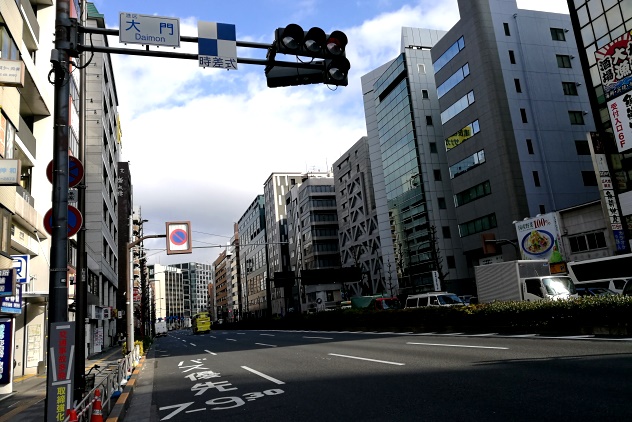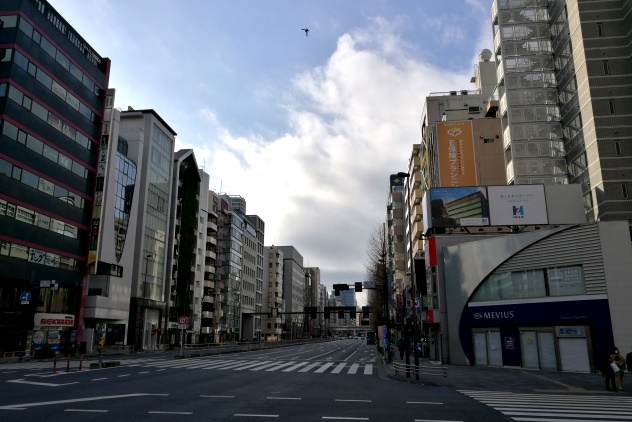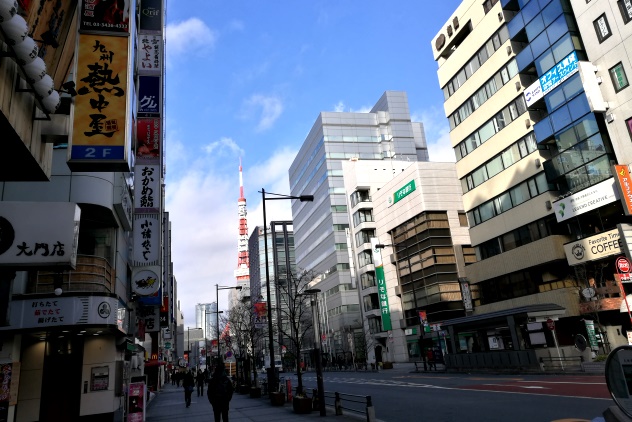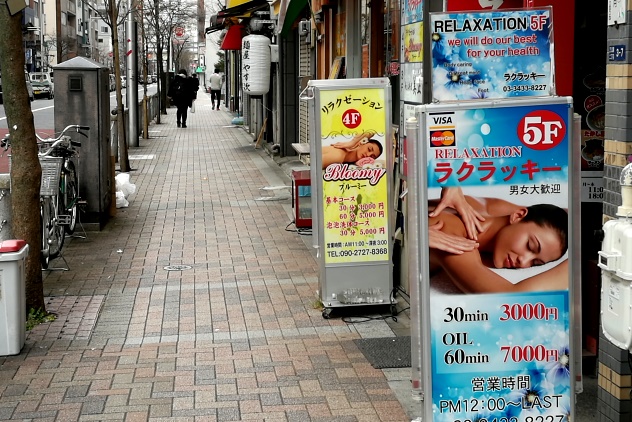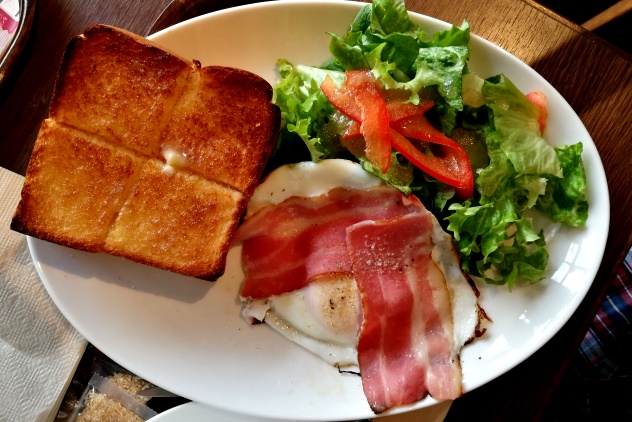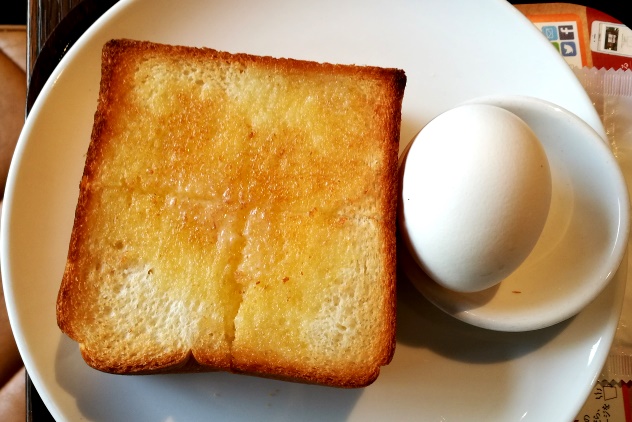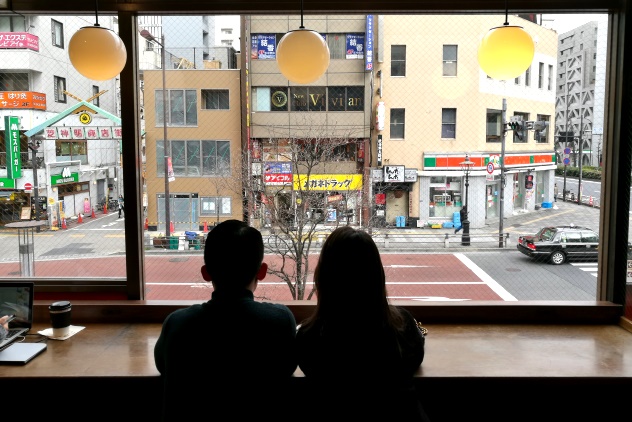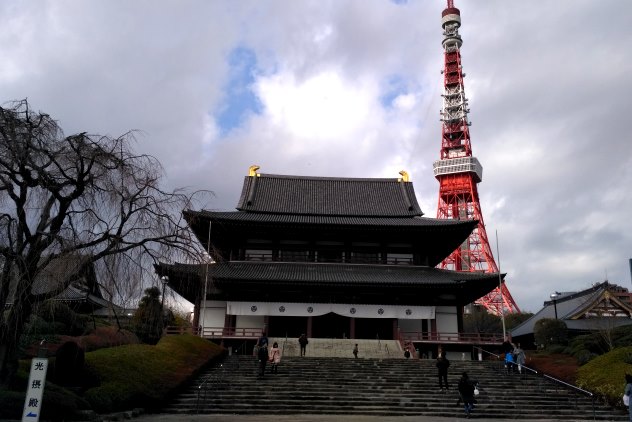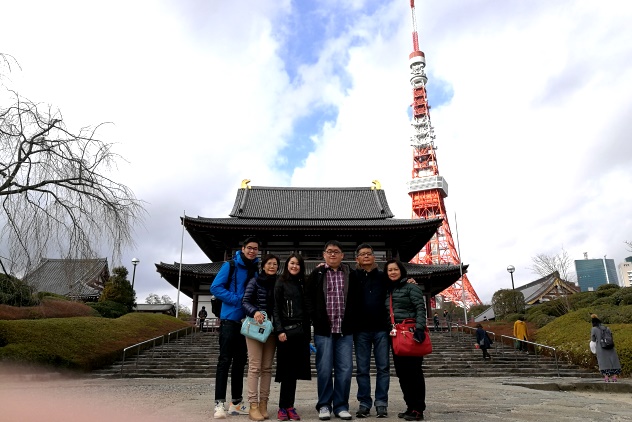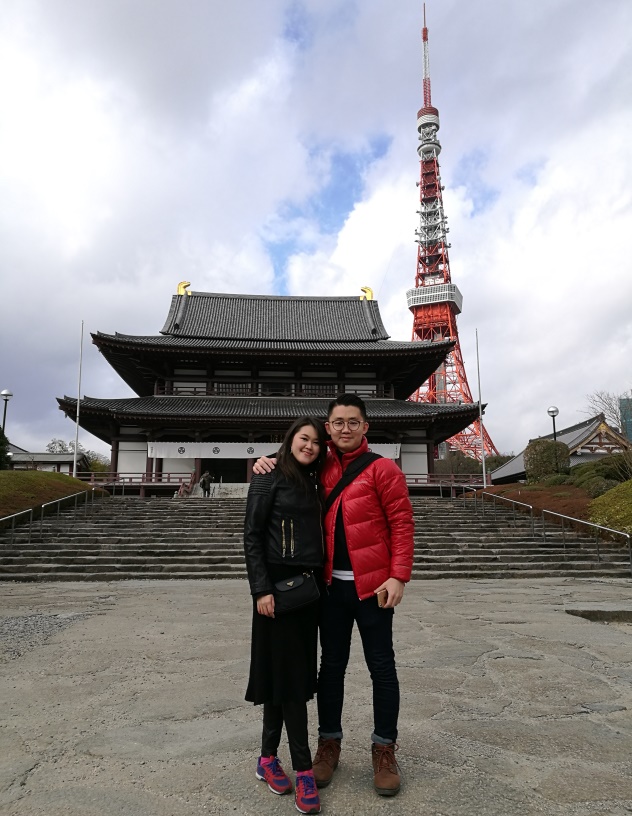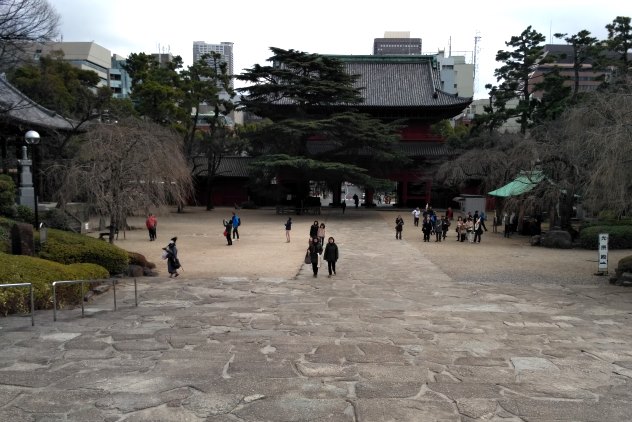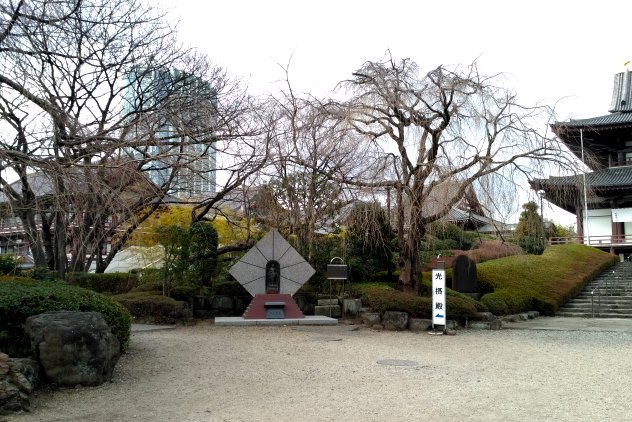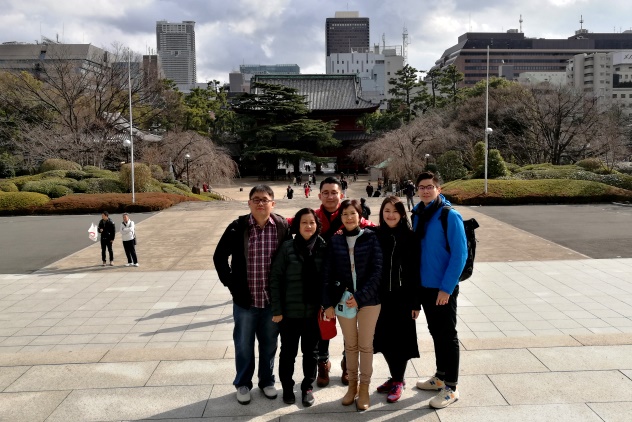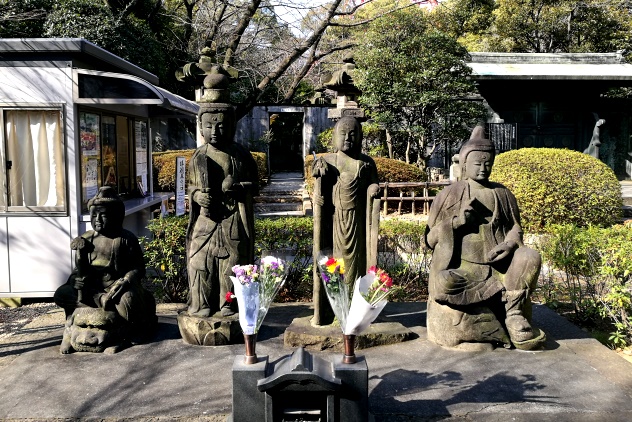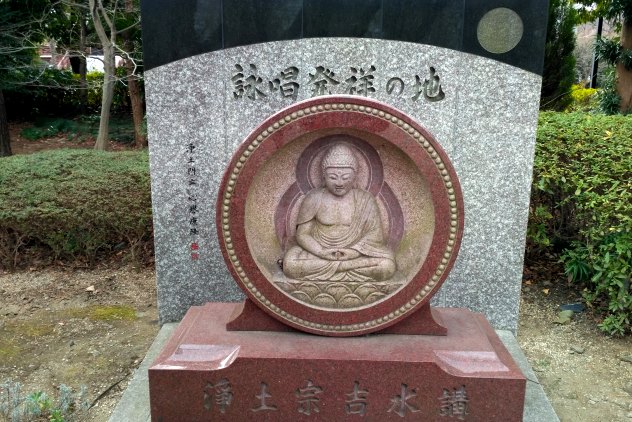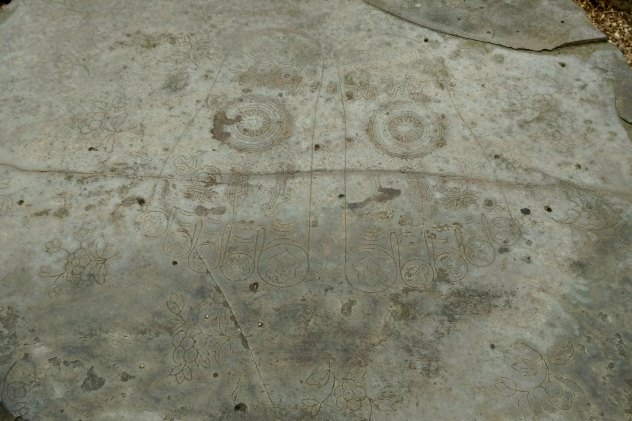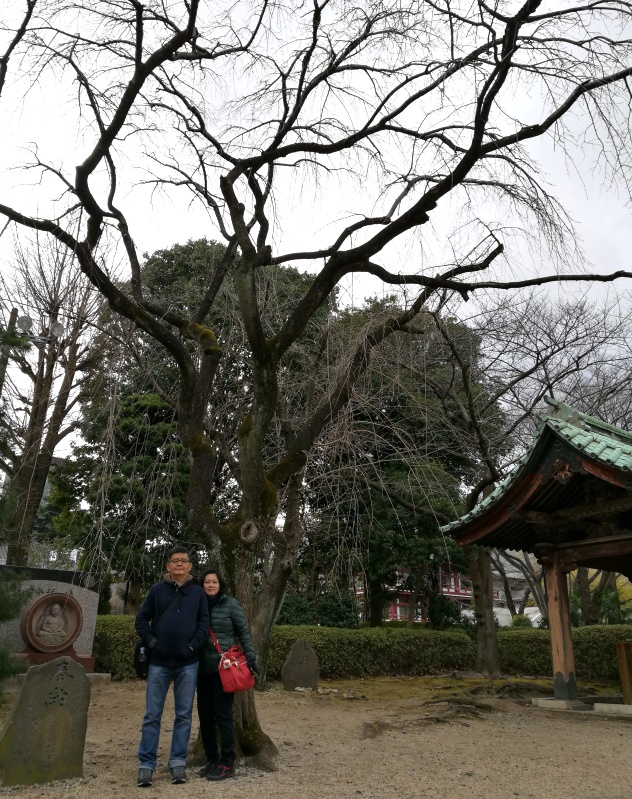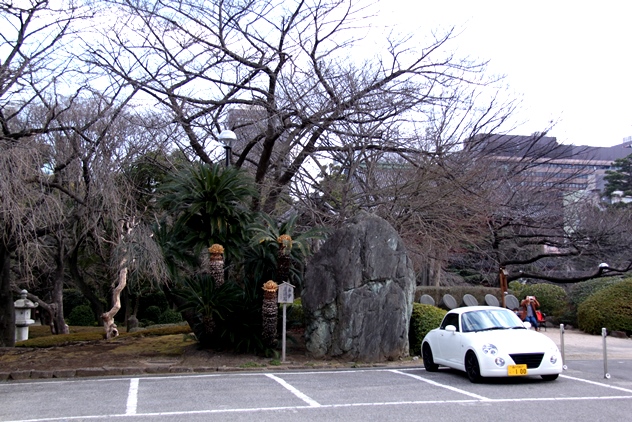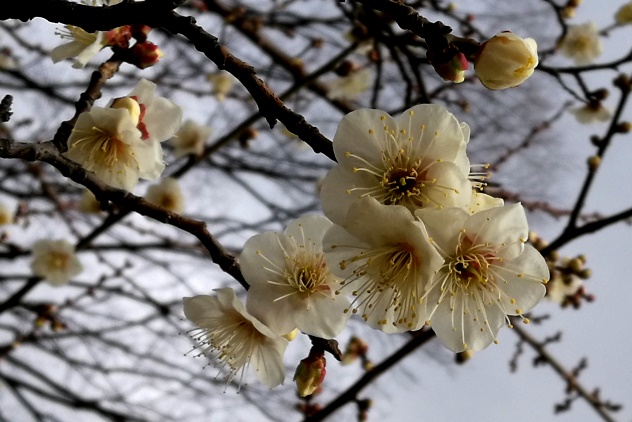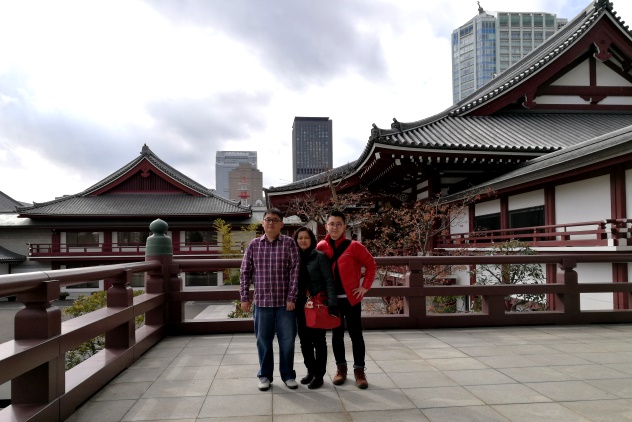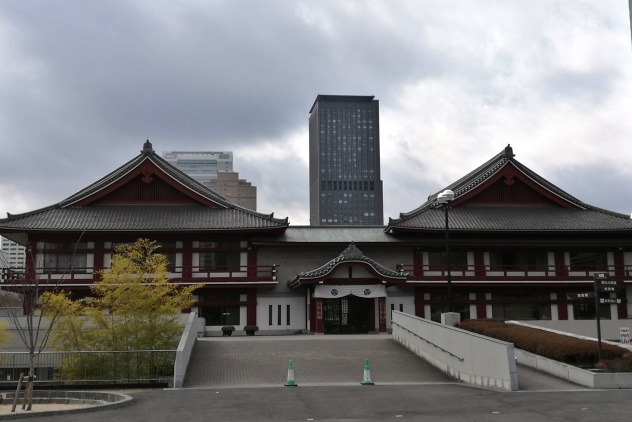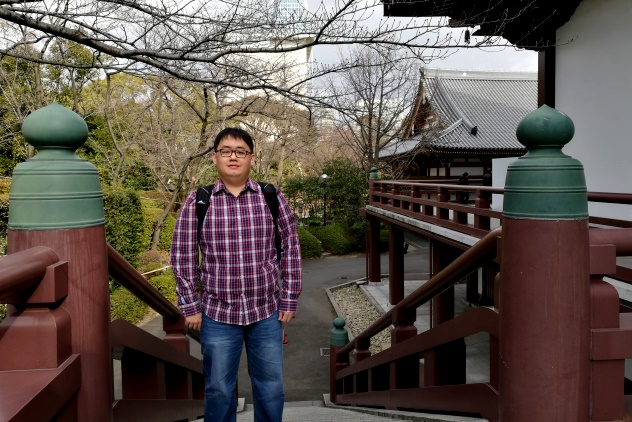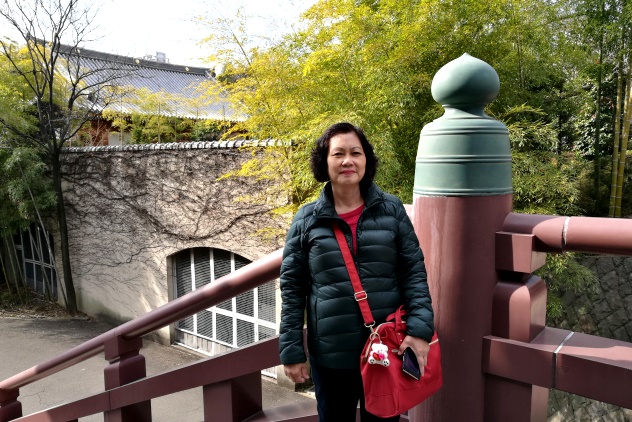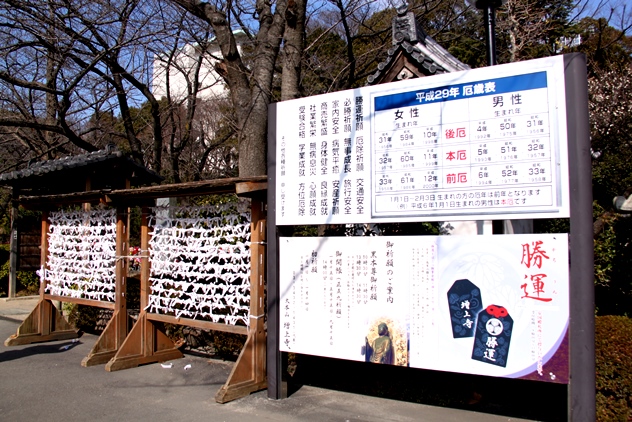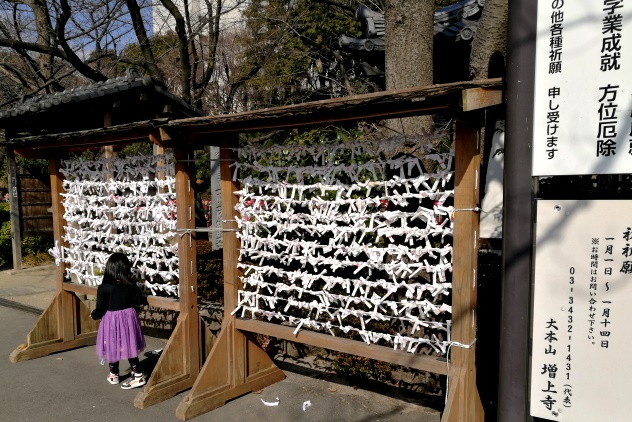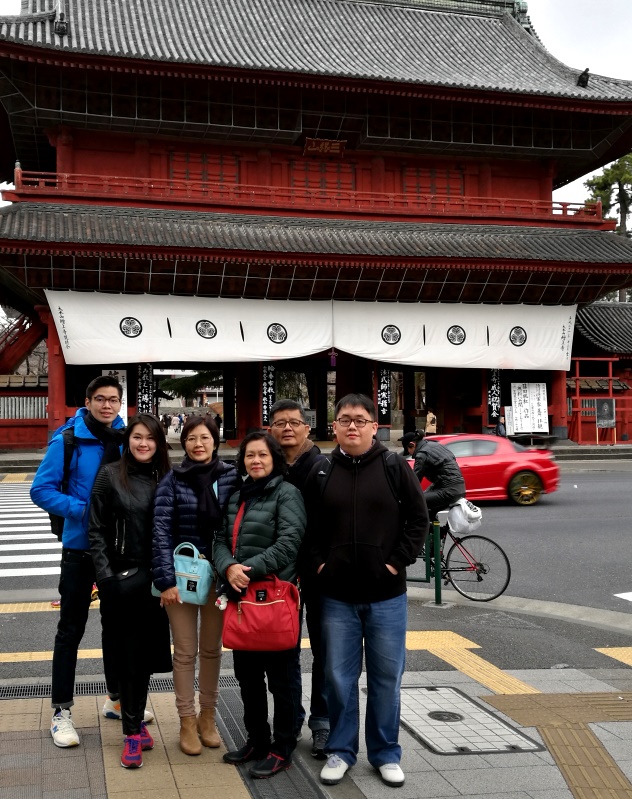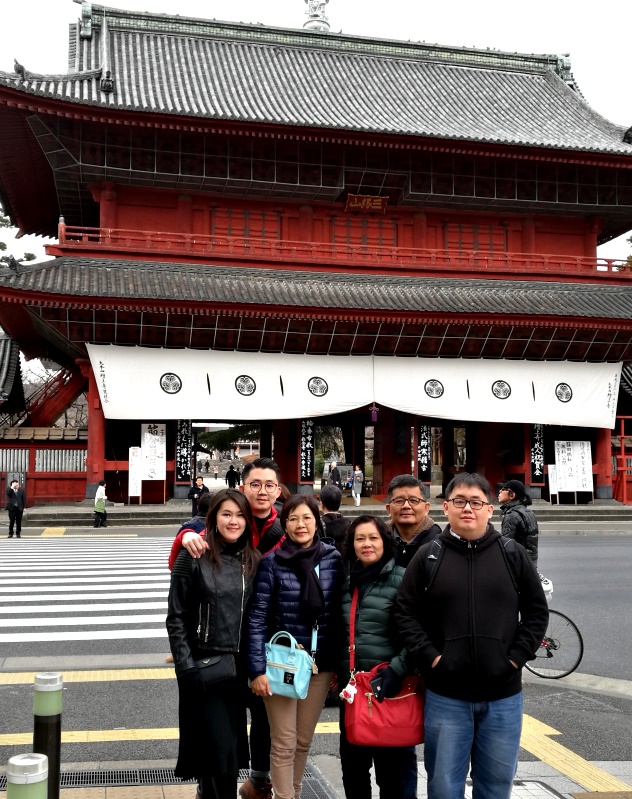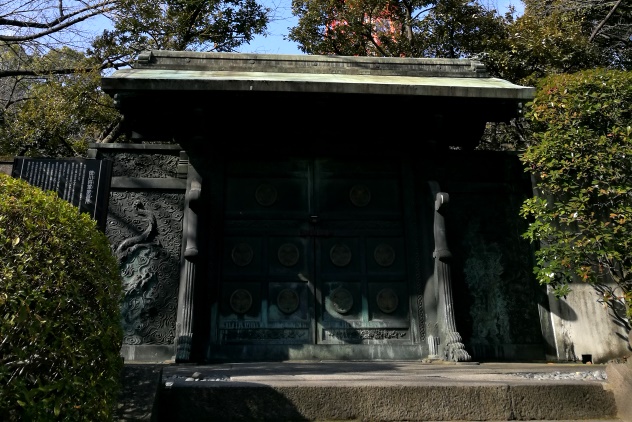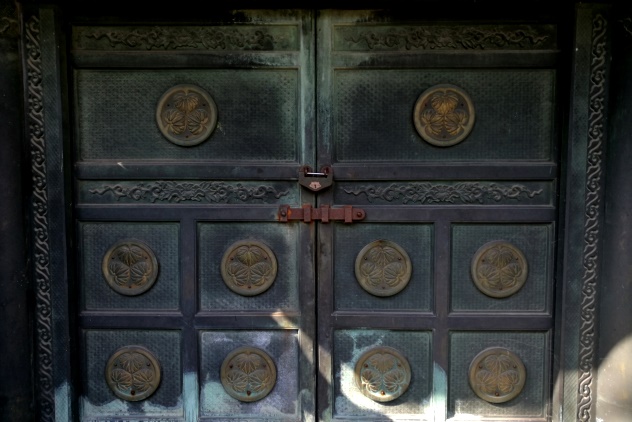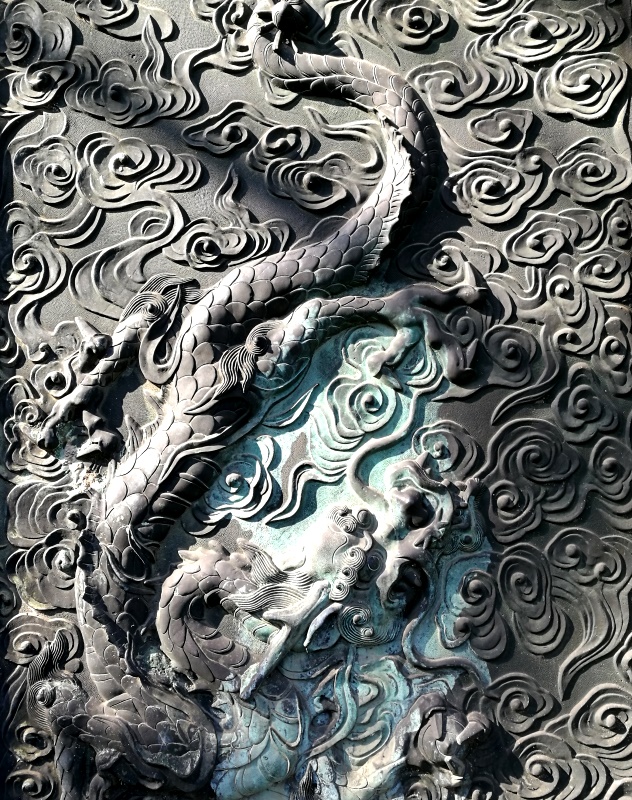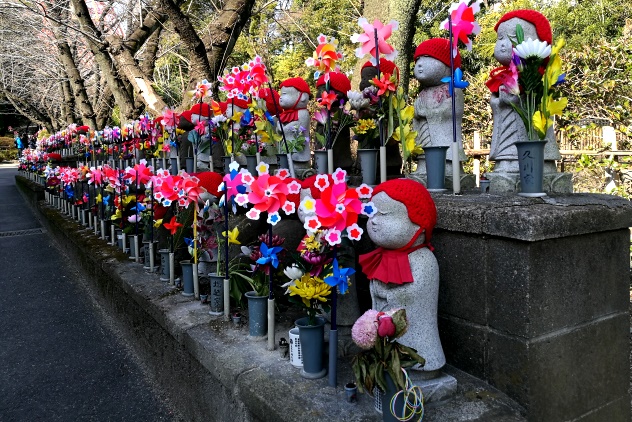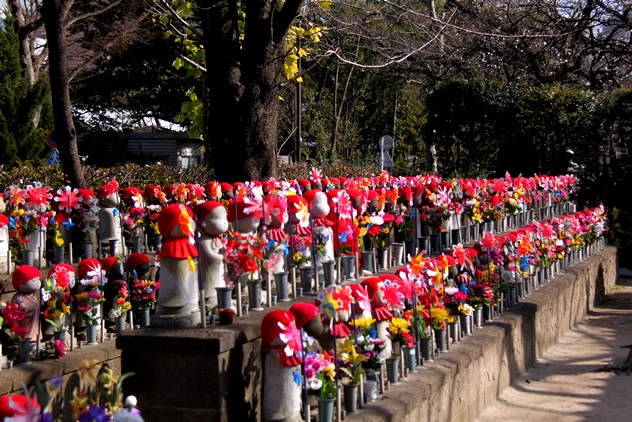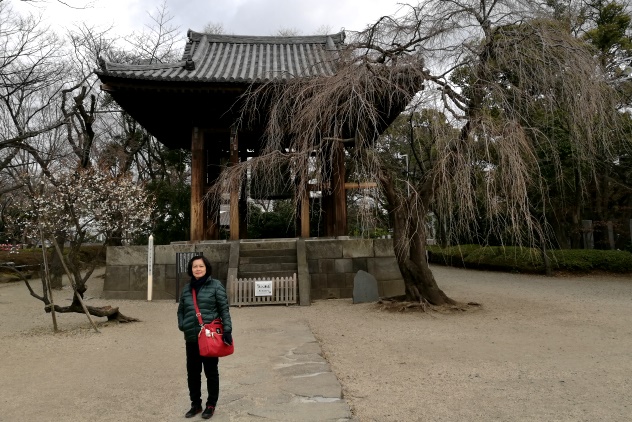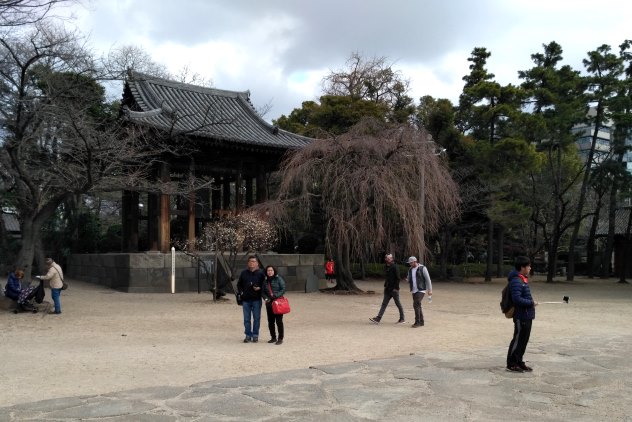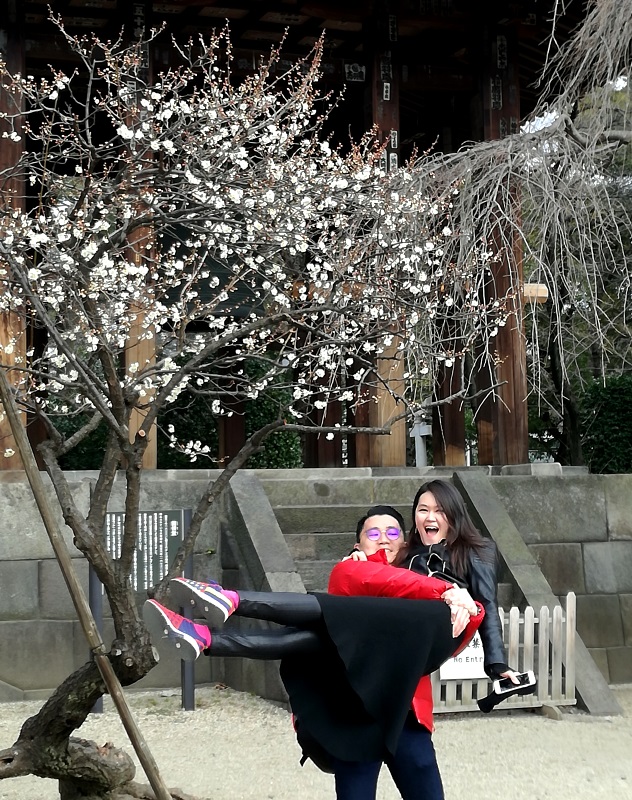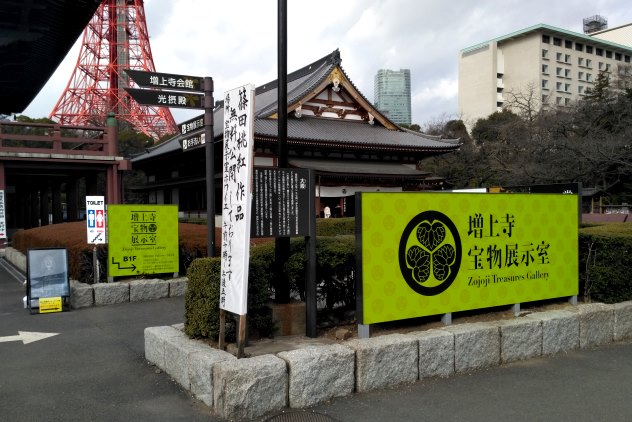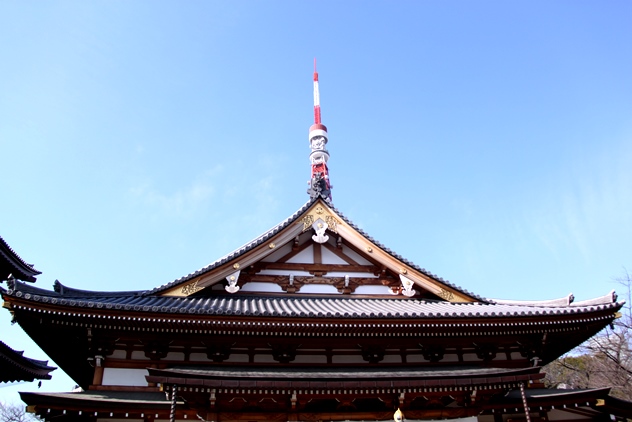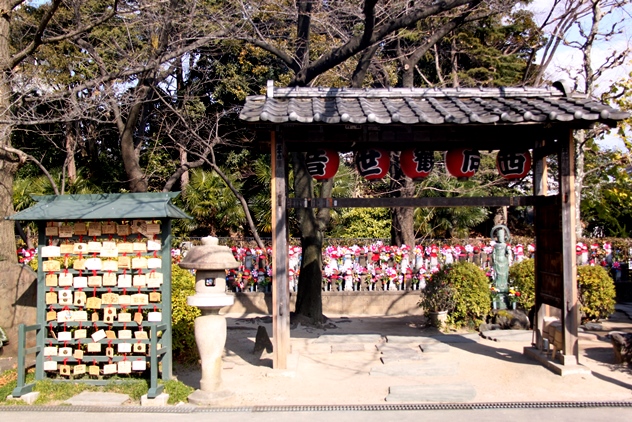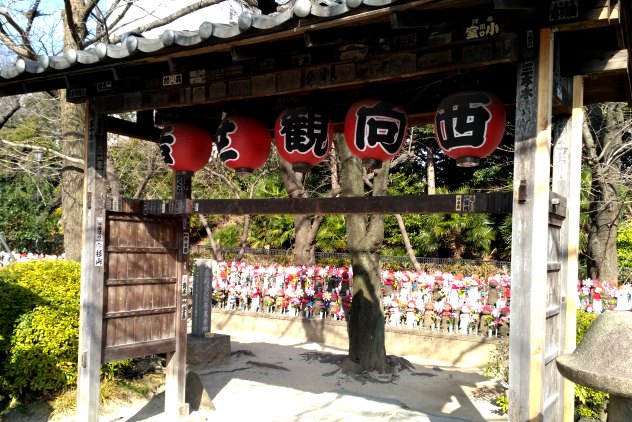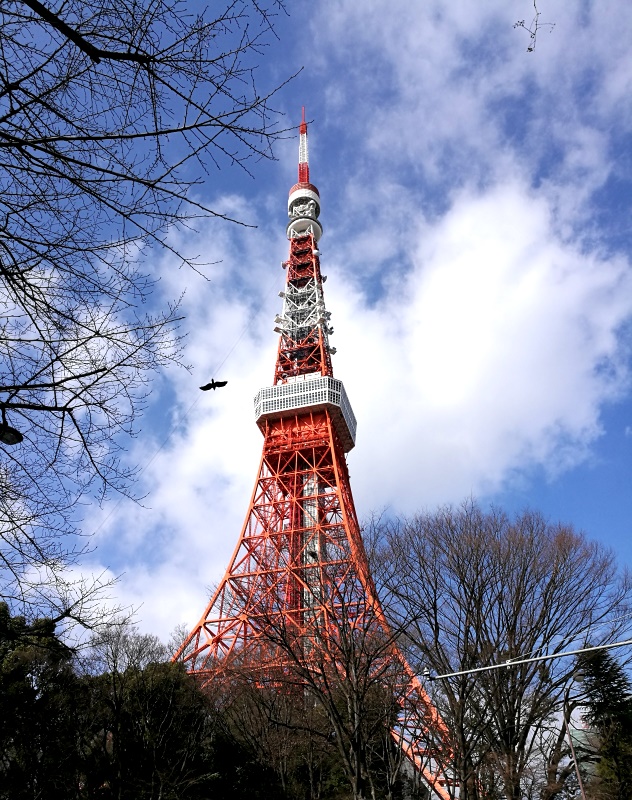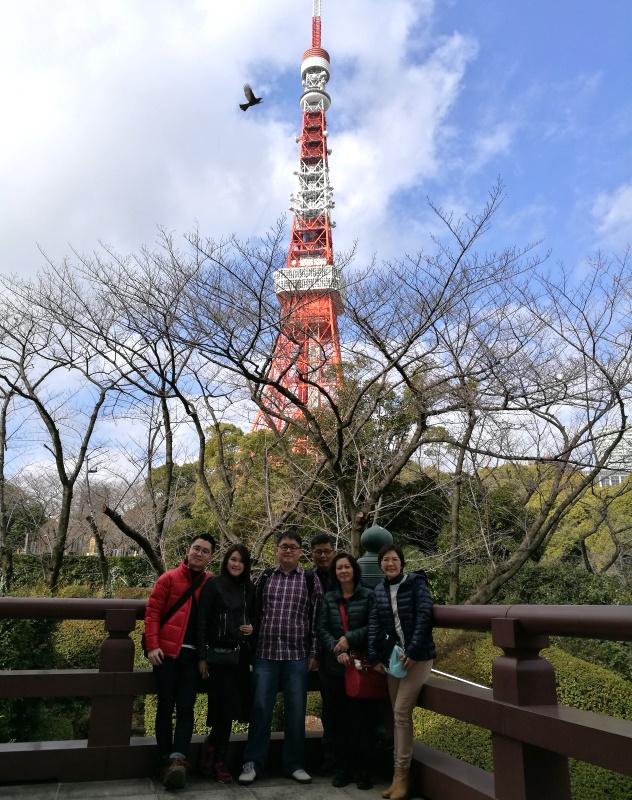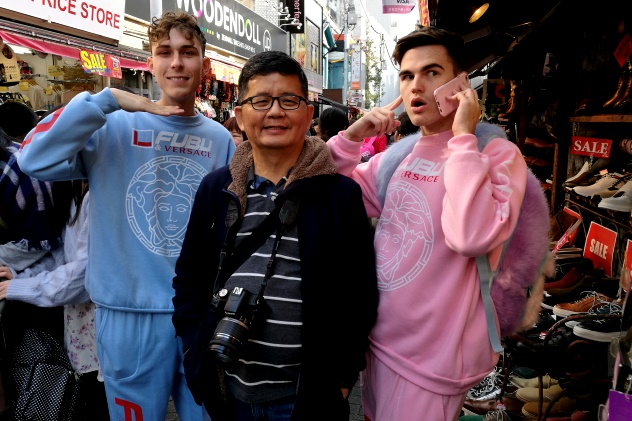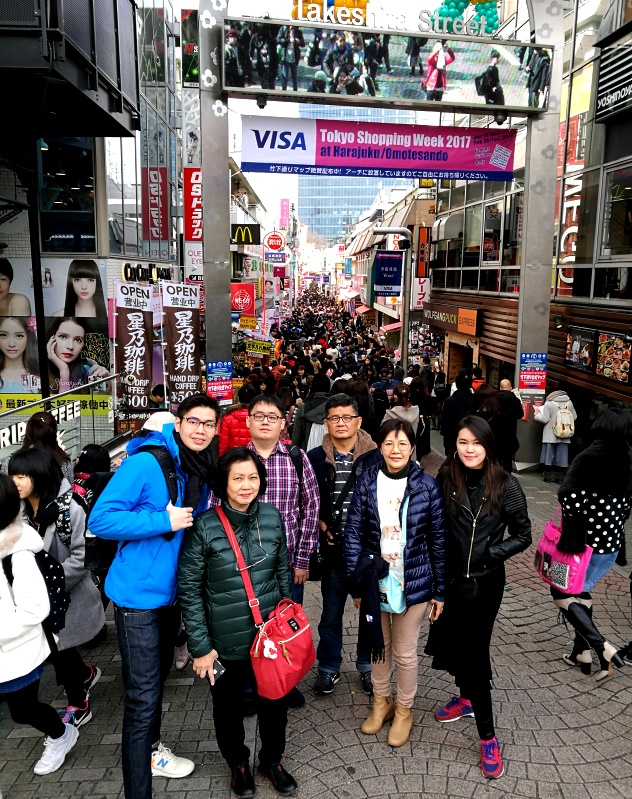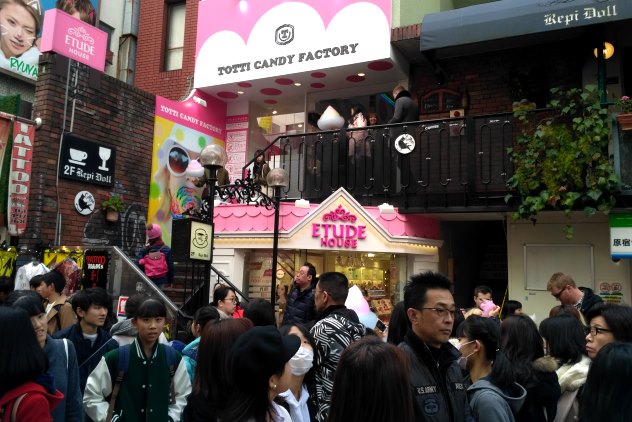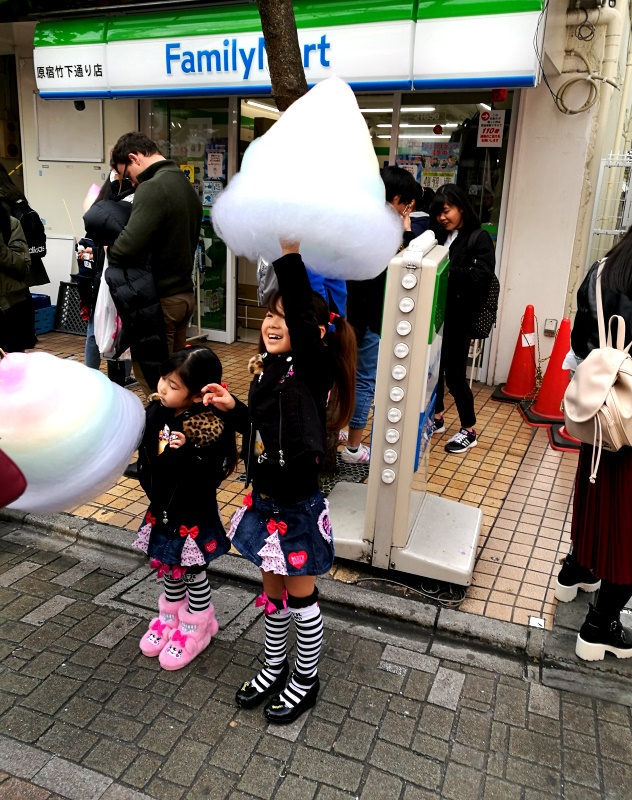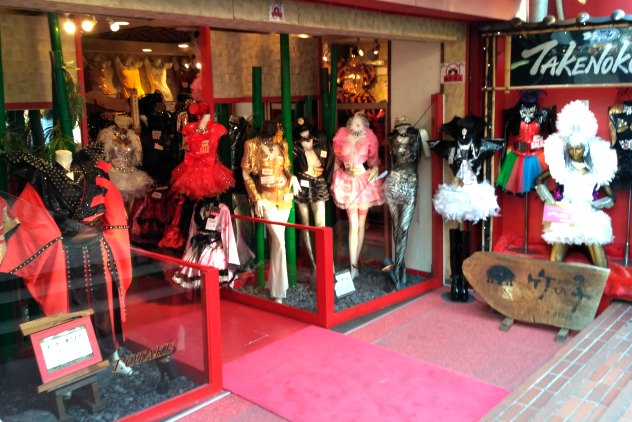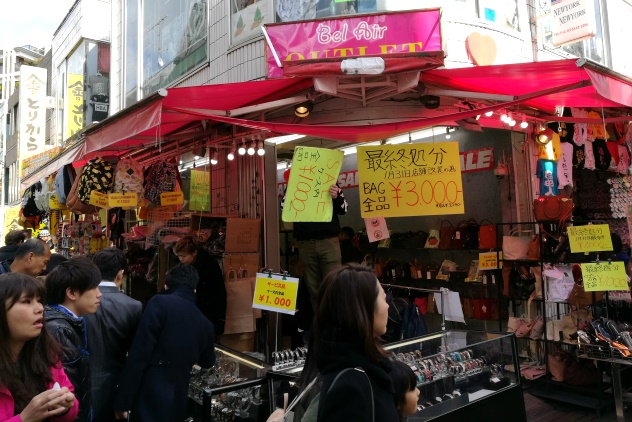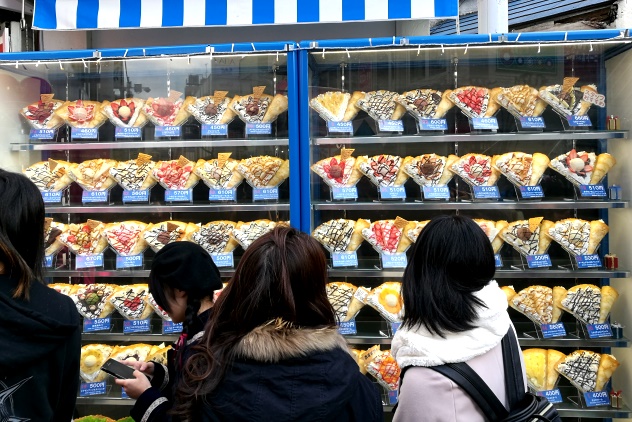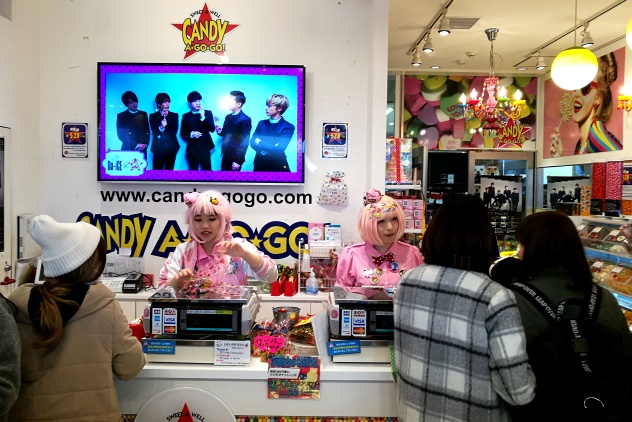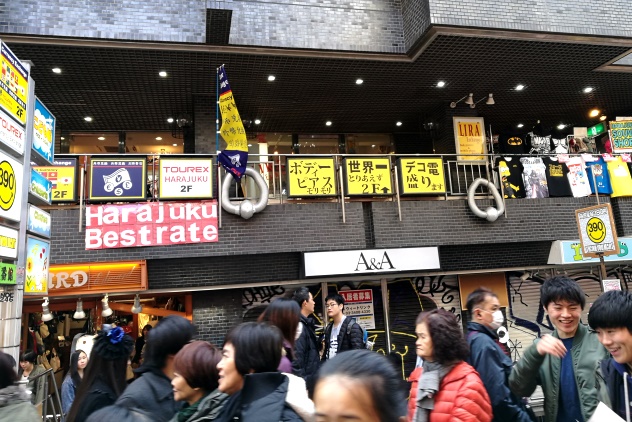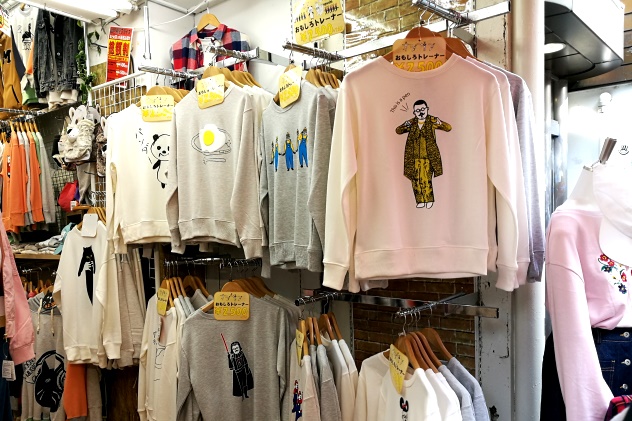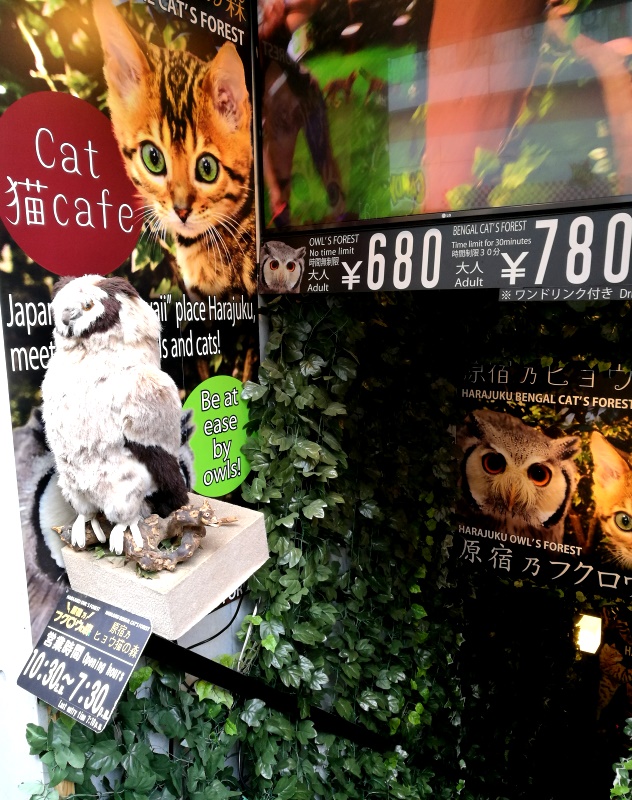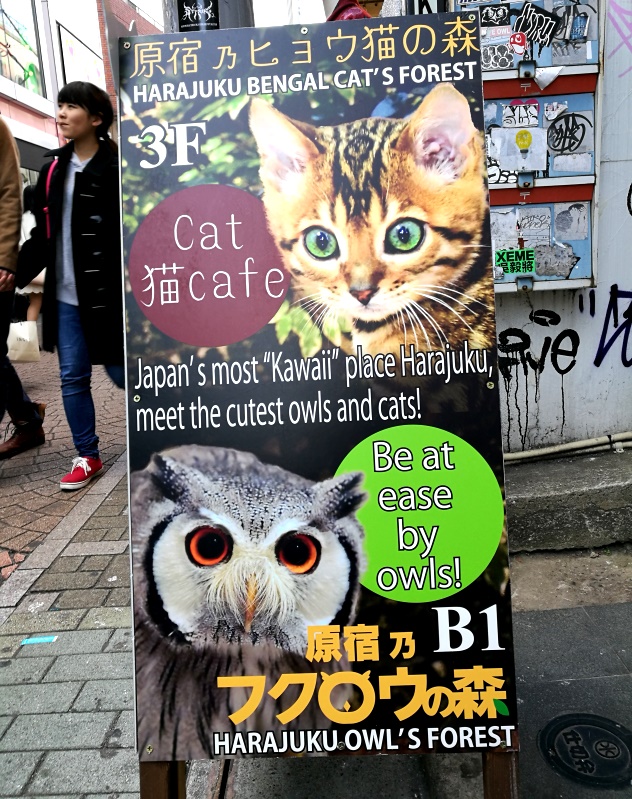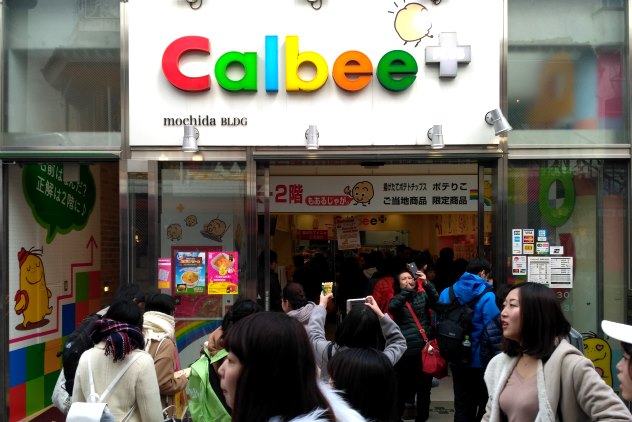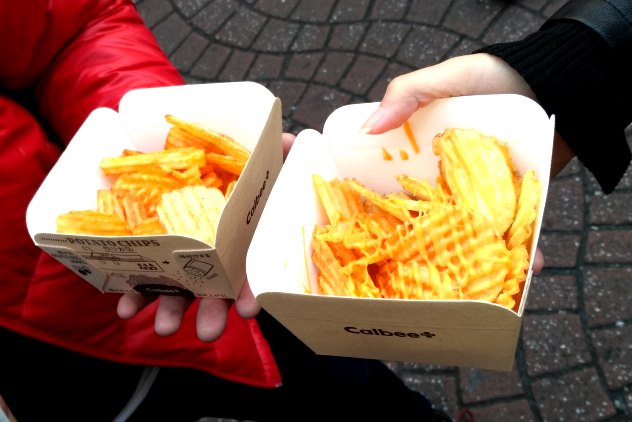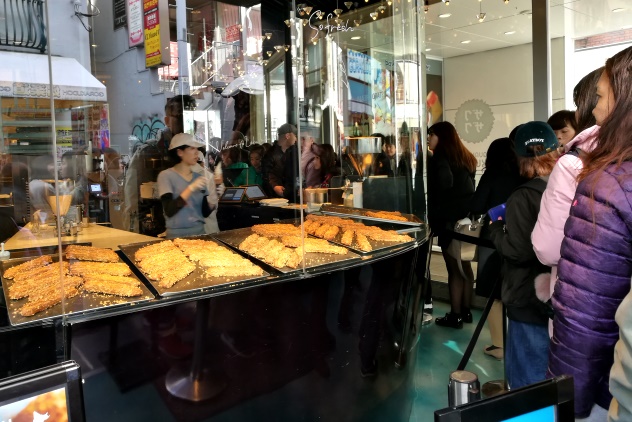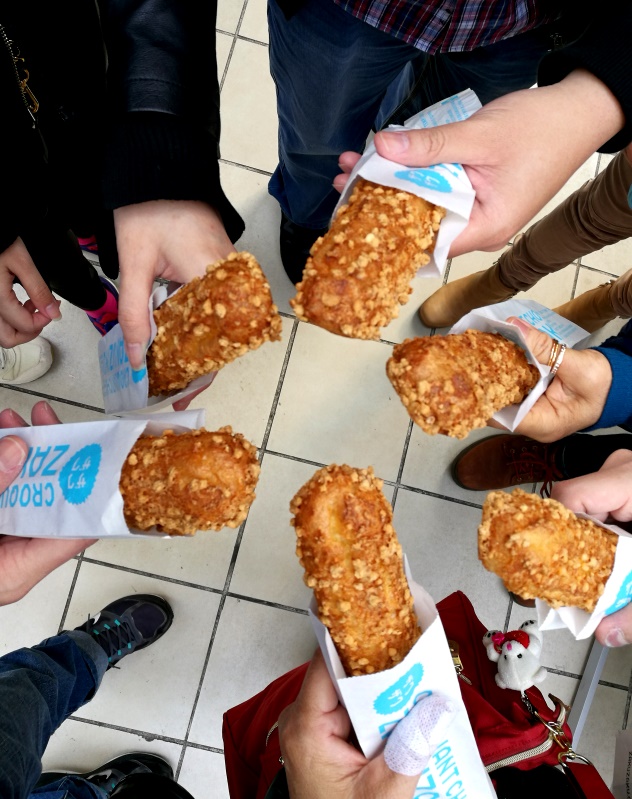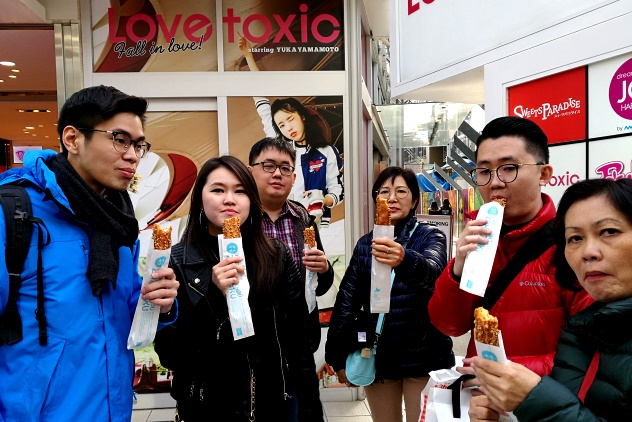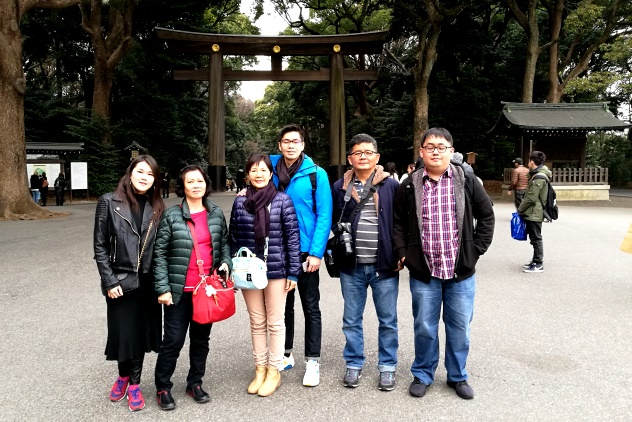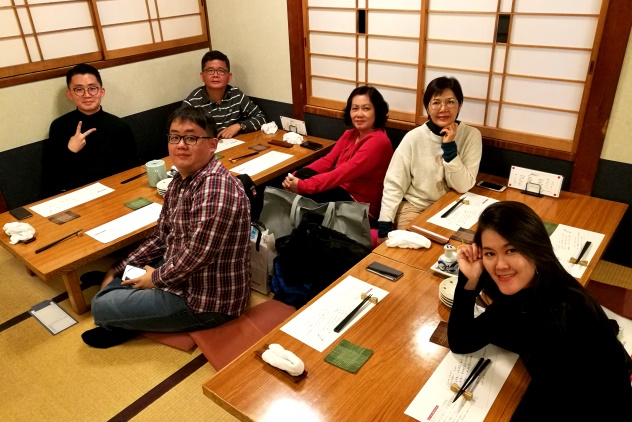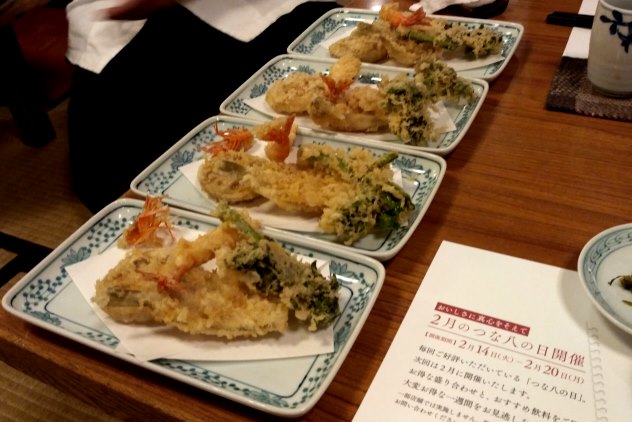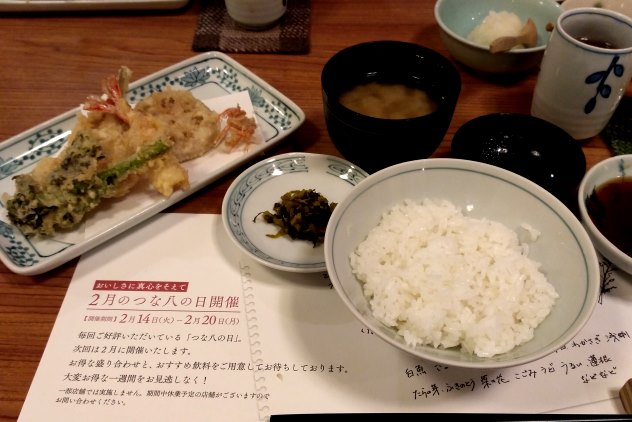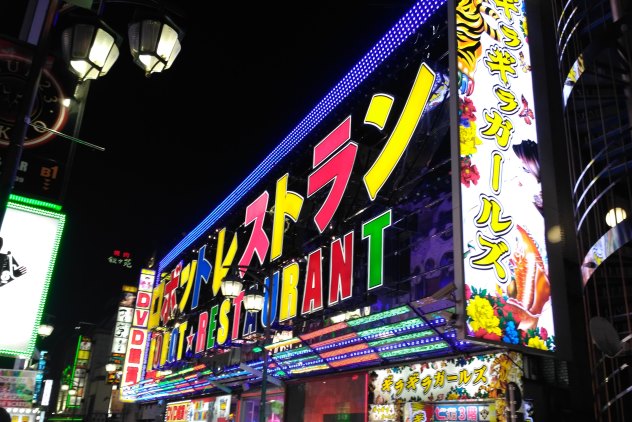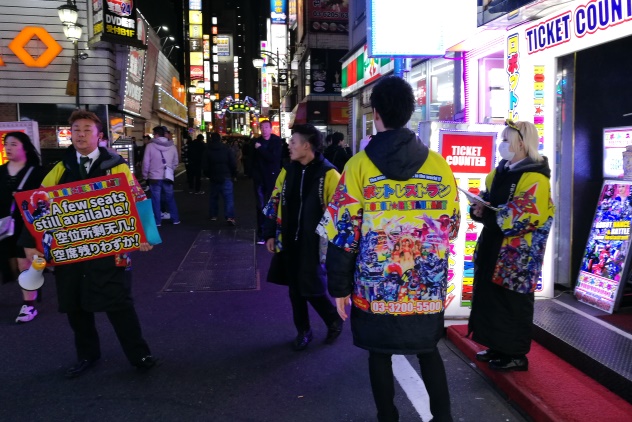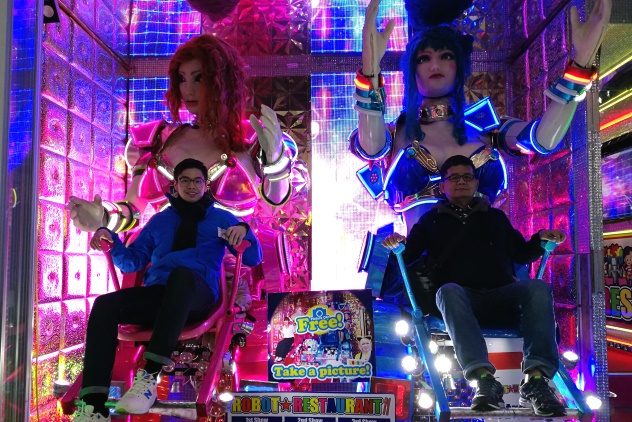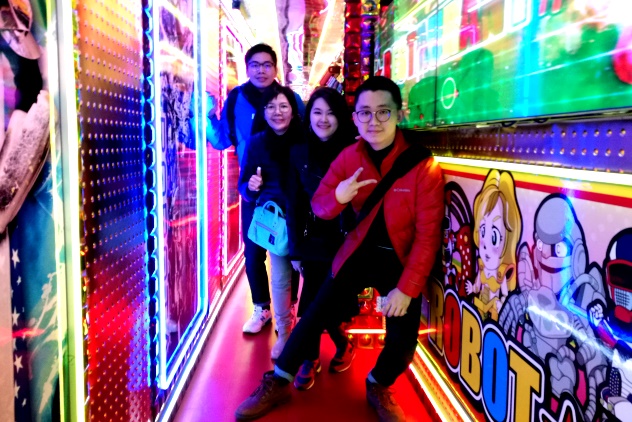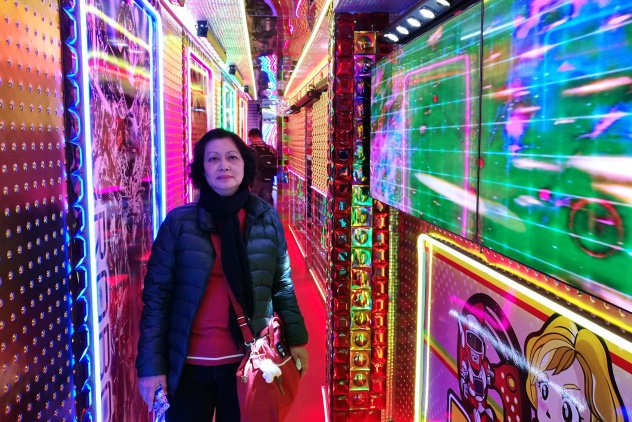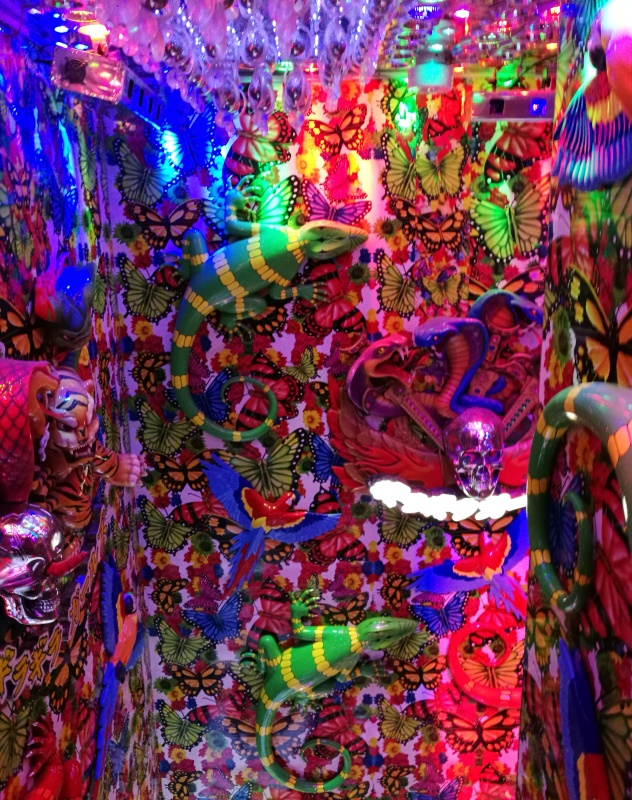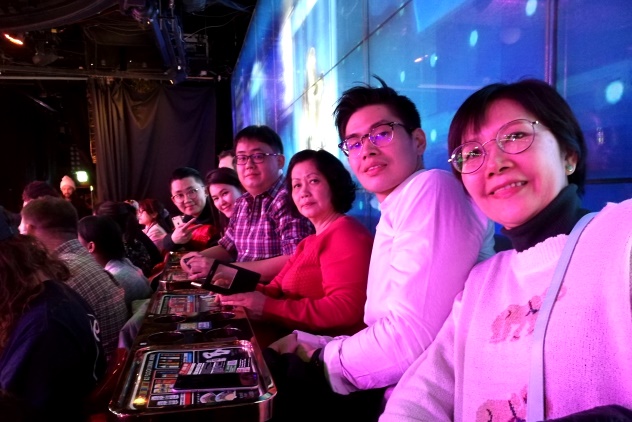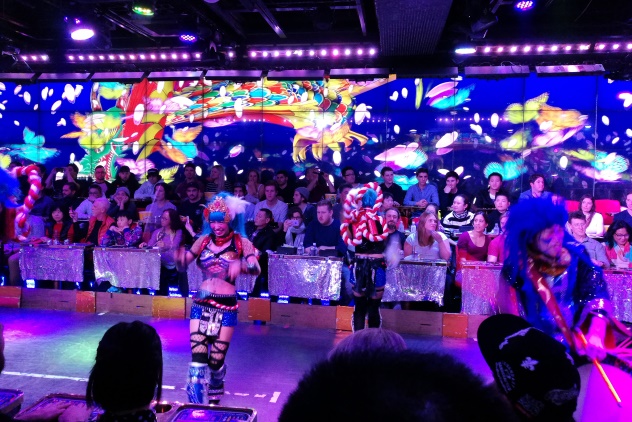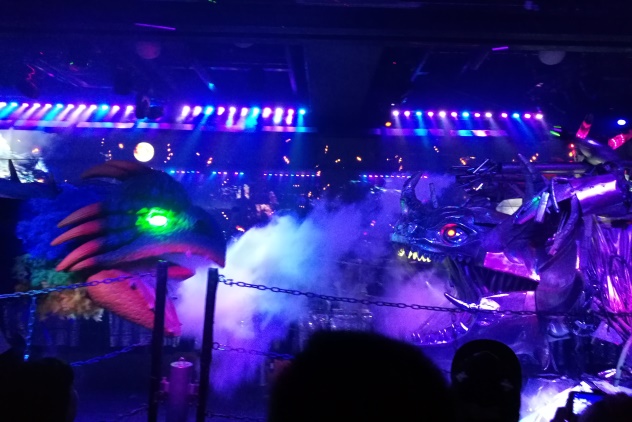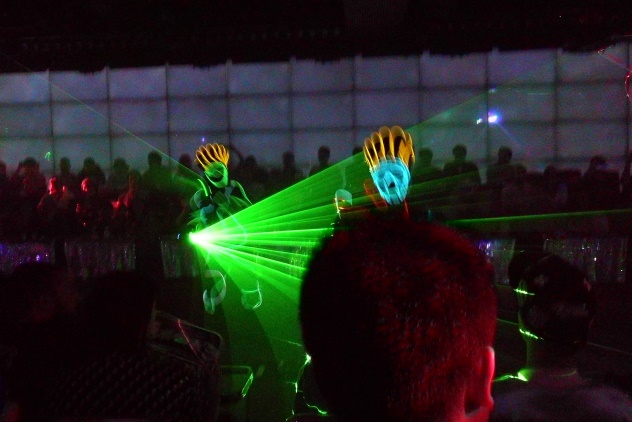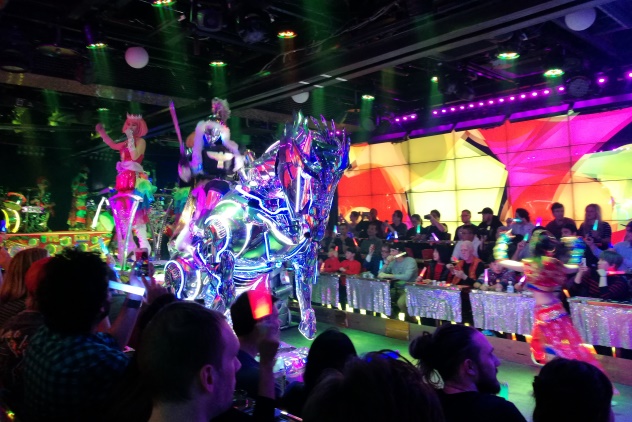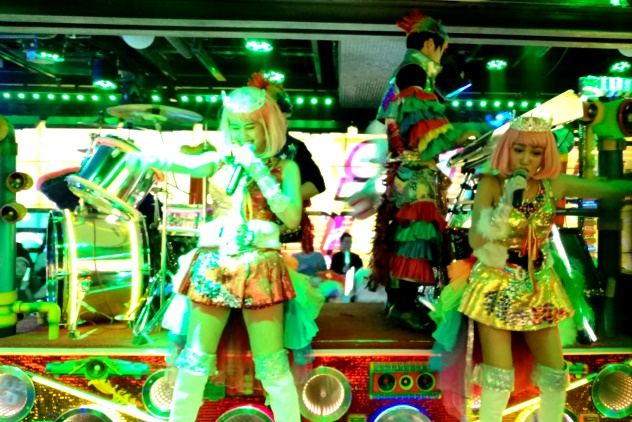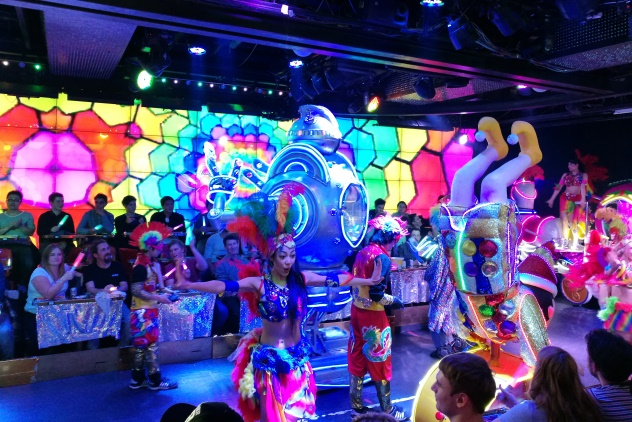January 29, our fourth day in Japan, was a Sunday. We were up quite early and hit the streets near our hotel in search of a place for breakfast. The streets were eerily quiet with little traffic and few people.
After breakfast, we took the subway to Daimon Station from where we then walked to Zojoji Temple. Zojoji, officially known as “Saneizan Kodoin Zojoji, is the main temple of the Jodo (Pure Land) sect of Buddhism. Zojoji was built in 1393 as the sect’s eastern Japan seminary and was relocated to its present site in 1598 by Tokugawa Ieyasu – the founder of the Tokugawa dynasty that ruled Japan in the Edo Period 1603-1868. The main hall of the temple has been destroyed three times by fire in the last century, the current building being a 1970s reconstruction. The main temple was rebuilt in 1974 by combining the traditional Buddhist temple architecture with a cream of modern architecture. Enshrined in this hall is a large main image (honzon) of Amida Buddha (made during the Muromachi Period), with an image of Great Teacher Shan-tao (who perfected China’s Jodo (Pure Land) Buddhism) at its right and an image of Honen Shonin (who founded Japan’s Jodo Shu) at its left. These images are deeply revered by many people who worship at Zojoji.
We took lots of photos of the main temple as well as interesting places in the temple grounds.The temple grounds were very spacious with lovely landscaped gardens, Buddha statues, Goddess of Mercy statue, buildings with interesting architecture and a stone image of Buddha’s foot. In the garden, we saw some plum blossom trees that were already blooming with lovely flowers.

Clarence in front of Dai-Nokotsudo, or Shariden(where the bones of the deceased are stored). It is made of stone and was built in 1933.
I also saw a lot of omikuji strips tied to strings on wooden racks. Omikuji is a strip of paper that predicts your fortune when you make a prayer to the gods and buddhas. So if you believe in fate and want to discover your fate, you can buy a omikuji. The results for omikuji range from the best “daikichi” (大吉 – excellent luck) to the worst “daikyou” (大凶 – terrible luck). Most people do not take a bad omikuji home. They tie the paper strip to a nearby rack.
Apart from the main temple, the other places on interest on the temple grounds are:
Sangedatsumon
The most historic element is the Sangedatsumon main gate – dating back to 1622 and the only surviving structure from the original temple. This huge 21 metres high gate is the oldest wooden structure in Tokyo. Each of its three sections represents three of the stages that are necessary to attain nirvana.
Tokugawa Mausoleum
A mausoleum of six Tokugawa Shoguns and their family members can be found on the temple grounds behind an iron gate decorated with fearsome dragons. Original pieces of their graves have been designated as Important Cultural Properties of Japan. With so much history and tradition guarded within, it’s no wonder Zojoji Temple continues to be an important Buddhist and cultural centre, and a spectacular monument to the might and power of the Tokugawa family in Tokyo.
Stone Jizo Statues
Another of the temple’s standout features is its cemetery for unborn children. The rows and rows of colourfully clothed and decorated stone jizo statues represent the souls of stillborn, aborted or miscarried babies. Parents use the statues as a way to say farewell and ease the child’s passage into the afterlife.
Daibonsho
This shorodo bell is just inside the grounds on the right after you enter the Sangedatsumon gate. Completed in 1673, it boasts a diameter of 1.76 meters, a height of 3.33 meters and a weight of 15 tons. It is renowned as one of the Big Three Bells of the Edo Period. The bell is tolled twice a day – six times each in the early morning and in the evening. It not only chimes the hours, but also serves to purify one hundred and eight earthly passions (bonno), which lead people astray, through an exhortation, repeated six times a day, to profound equanimity.
Ankokuden
Enshrined in this building is the Black Image of Amida Buddha, which was deeply worshiped by Ieyasu Tokugawa. This wonder-working image is said to have repeatedly saved Ieyasu from dangers and enabled him to win battles. Since the Edo Period, it has been widely revered as a Buddhist image which brings victory and wards off evils.
Shofuku Jizo
In harmony with the Nishimuki Kannon, also known as the God of successful parenting and childbirth, there are 1300 Shofuku Jizo or Buddhist deities here.
Just behind the Zojoji Temple is the Tokyo Tower. We did not go to the Tokyo Tower but took quite a lot of photos of it from the temple grounds. Standing 333 meters high, Tokyo Tower is the world’s tallest, self-supported steel tower and 13 meters taller than its model, the Eiffel Tower. A symbol of Japan’s post-war rebirth as a major economic power, Tokyo Tower was the country’s tallest structure from its completion in 1958 until 2012 when it was surpassed by the Tokyo Skytree. In addition to being a popular tourist spot, Tokyo Tower serves as a broadcast antenna.
From Zojoji Temple, we took the subway to Harajuku. Harajuku refers to the area around Tokyo’s Harajuku Station. It is the epicentre of Japan’s most extreme teenage cultures and fashion styles. As we strolled around, we saw people dressed in cute and sometimes bizarre costumes.
The focal point of Harajuku’s teenage culture is the famous pedestrian-only Takeshita Dori (Takeshita Street) and its side streets, which are lined by many trendy shops, fashion boutiques, gift shops, used clothes stores, crepe stands, cafes and fast food outlets geared towards the fashion and trend conscious teens.When we strolled along Takeshita Dori, we found ourselves suffering from sensory overload, surrounded by toys, clothes, gift items and snacks that were so cute.
As we walked around Harajuku, we tried out freshly baked Calbee chips, the famous Zazuzaku Croquant Chou and a Japanese ice cream, all of which were delicious.
From Harajuku, we walked to Meiji Shrine (Meiji Jingu). Meiji Jingu Shrine (明治神宮) is one of the most popular shrines in Tokyo and is a must see for anyone visiting Tokyo. On the way, we passed through Omotesand. Referred to as Tokyo’s Champs-Elysees, Omotesando is a wide tree lined one kilometer long avenue in Harajuku. Numerous stores, boutiques, cafes and restaurants, including several leading fashion brand shops, stand along the avenue. This area generally caters to an older and wealthier clientele than Takeshita Dori.
Meiji Jingu Shrine is a great contrast to the hustle and noise of Tokyo with the forest of 120,000 evergreen trees blocking out the noise of the city. The forest of 365 different species of trees covers an impressive 700,000 square-meters (about 175 acres).
Meiji Jingu Shrine is dedicated to the souls of Emperor Meiji and his wife, Empress Shoken. The shrine was built in a garden area where Emperor Meiji and Empress Shoken sometimes visited before their deaths in 1912 and 1914 respectively. Meiji Jingu Shrine was built after this, in the Nagarezukuri style, constructed mainly with Japanese cypress from Kiso. Japanese cypress is generally considered the best timber in Japan.
When we arrived at the shrine’s landmark entrance, the 40-foot tall Meiji Jingu Torii (gate), it was way past 5pm and the entrance was about to be closed for the day. We could still enter if we wanted to but that would mean we would have to walk to the Meiji Shrine and get out from the exit at the other end. That would take quite a while if we want to take in the sights and take photos as we go along. We had booked the tickets for the 7.30pm Robot Show at Robot Restaurant in Shinjuku and we were told to be there by 7.00 pm or else our bookings would be cancelled. We felt that time was not on our side so we decided not to visit the Meiji Jingu Shrine. We just spent a bit of time at the entrance to take some photos.
We then made our way to Harajuku Station and took the metro to Shinjuku, a major commercial and administrative centre. Shinjuku is home to the Shinjuku Station and the Tokyo Metropolitan Government Building, the administration centre for the government of Tokyo. Shinjuku Station is the world’s busiest railway station, handling about 3.5 million passengers every day. It is served by about a dozen railway and subway lines.
Shinjuku can be roughly divided into three areas: the West Exit area, an office town with a row of high-rise buildings such as the Tokyo Metropolitan Government Office Building; the South Exit area, a newcomer to Shinjuku with complex establishments for shopping and amusement; the East Exit, the prominent entertainment district around Kabukicho, a red-light district off Yasukuni-dori Avenue.Kabukicho is renowned for its thousands of hostess bars and its numerous love hotels. The infamous yazuka are out and about here and the African touts here can make some people nervous but it is safe enough even at night.
We had a quick dinner at Tempura Shinjuku Tsunahachi.
After dinner, we made our way to Robot Restaurant to catch the Robot Show scheduled to start at 7.30 pm. The Robot Restaurant with its huge brightly-lit signboard is pretty difficult to miss. Outside the restaurant are two chairs with female robots for patrons to take photographs. Staffs dressed in colourful outfits were on the streets trying to lure passersby to attend the show.
Robot Restaurant, opened in July 2012, is the only entertainment outfit of its kind in the world and an attraction for clientele ranging from world-class celebrities to ordinary folks. Despite its name, Robot Restaurant is more of a glittery show than a place to eat. Anthony Bourdain said it is one of the greatest shows in the world. Fitted out at a cost of ¥10 billion (RM390 million!), Tokyo hasn’t seen anything like this.
Around the Robot Restaurant are seedy things with a Japanese twist. You will see young pretty Japanese women giving away free packets of tissue with contact numbers to call if you want their “special service.” Japanese bouncer-like characters and African touts hang around on the streets. My son Clarence had earlier warned me about taking photos of such characters as they probably belong to yazuka gangs so I restrained myself from taking photos of these ladies and bouncers.
As we made our way upstairs to the lounge area of the restaurant to wait for the show to begin, we were dazzled by the brightly-lit colourful passageways.
The lounge is a very glitzy place, reminding me of a combination of theme park, mardi gras and strip club. We were entertained by a band with some band members dressed in robot suits. The female Japanese lead singer poured so much emotion into her singing.
After a wait of about 20 minutes in the lounge, we were herded downstairs through narrow mind-blowing colourful hallways into the basement that surely would have been our graves had there been any sort of fire. The area didn’t seem big enough for a big robot show, but looks were deceptive.
As for the show itself, I don’t really know what to say about it. It involves flashy scantily-clad dancers, potentially seizure-inducing laser light shows, dinosaurs, taiko drums, robots and other oddities. You can read a more detailed write-up in my other blog post entitled “Sensory Overload At Robot Restaurant Tokyo”.
After the show, we were tired and decided to call it a day. But what a most memorable day it had been!
 CY@CY Says Welcome to my dreamscape. Where a Lim is also a Ling.
CY@CY Says Welcome to my dreamscape. Where a Lim is also a Ling.
